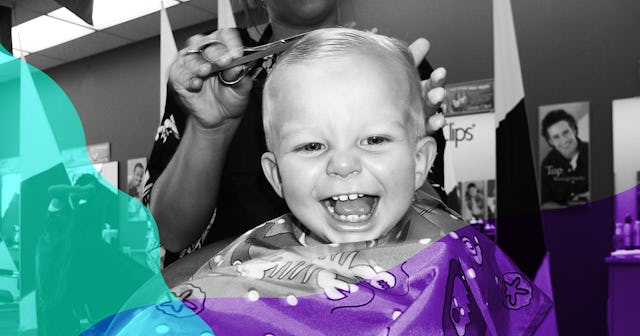Haircuts Are A Perfect Opportunity To Teach Children About Consent

I took my 4-year old to get her hair cut recently and we both had a bizarre experience. A few chairs away from us, a girl about my daughter’s age was weeping as her parent directed the stylist (who was trying to soothe the girl, promising that it wouldn’t hurt) regarding the length and style the parent wanted. As I buckled my girl’s car seat to head home, she had questions (she has a LOT of them these days, a characteristic of being a 4 year old): Why didn’t that girl get to choose her hair cut? Why didn’t they wait until she could catch her breath and stop crying? Momma, why did they keep going after she said stop?
I told her I didn’t know, and that different families make different choices (also a phrase I repeat most days). There are certainly circumstances in which haircuts can be difficult and stressful, especially for people with sensory sensitivities — and I try hard to reign in my own disposition to judgement because it isn’t one I want to pass on to my kid, so we did not dwell on it. Days later, I’m still feeling uncomfortable about the lesson she gleaned from watching that — which motivated this ascension to soapbox to highlight what a simple trip to the salon can teach our kids about how our world works.
When my kid climbed into the chair, the stylist asked me how I wanted her hair to be cut. I redirected the question to my kid. The stylist showed me with her fingers where she planned on cutting it and asked if it was OK. Again, I asked her to show and ask my kid. While the stylist was washing her hair, my kid made a face I didn’t recognize and the stylist asked her if the water was OK. When my kid didn’t answer, I asked they stylist to pause (she was finishing up rinsing shampoo out) and said a phrase I repeat most days: “Please use words to tell us how you want your body to be treated. We want to understand because it is your body and your choice.”
Heads swiveled. I know salons can be judge-y places, but these weren’t glaring eyes — maybe confused or interested. It felt like we were doing something “weird,” though it is definitely our normal.
Paige Smock/Reshot
My daughter said, “Stop. I don’t like it.” And the stylist replied, “OK, I can just do a leave-in conditioner, then.” (Kudos to her, she had been paying attention.)
Shopify Partners/Burst
There is no part of me that thinks for a moment the parent with that crying kid in the chair wants anything but the best for that kid. I think I’m probably the one who’s the “weird parent.” But I believe (and act upon) the premise that every reasonable chance I can find to let my kids practice bodily autonomy is one step closer to a world in which people having respectful, consenting relationships with clear communication is the norm.
Shopify Partners/Burst
I don’t want to be the weird one, though — I want more of y’all to join me in recognizing that actively seeking opportunities to allow kids (and people) to reflect on their personal preferences, articulate them, and have those requests cheerfully and respectfully honored is not only critical for improving our society, but pretty simple to do.
I wasn’t always this way. I clearly remember the first time I asked a mom if I could hold her baby and she responded with “Ask her,” and it legitimately confused me. I have done significant learning, formal and informal, in the topic of fostering healthy relationships with young children that will support their ability to establish and maintain healthy relationships with others. Watching “respectful” or “progressive” parents and teachers (and humans) interact with kids (and humans) is a simple way to see that establishing a respectful dynamic built on a foundation of consent from infancy is not only possible, but desirable. It equips babies and toddlers to communicate more clearly, and us as caregivers to be careful observers of their earliest attempts to communicate — which yields significant impact, short and long term.
It was jarring to me that our experience at the salon drew the attention of onlookers but the screaming kid did not — sure, people were (hopefully) averting their eyes as to not make that parent feel awkward- but I got the feeling that child had a more common experience than mine.
While I know there is no authentic way to discern what is “normal” parenting, we know it evolves with time and knowledge. I am hopeful that a new norm is on the horizon in which it is assumed that children have their own agency and are able to have and communicate preferences in the first years of their lives. Parents are now collectively aware that children need car seats and that babies should be placed to sleep on their backs on a flat surface without a blanket — two new norms that have emerged since I was a kid, and saved many lives since then.
I can’t predict the exact outcome of the impact of teaching and practicing navigating bodily autonomy and consent, but I know that it can create a generation of people who are more self-aware, confident, and articulate about asserting their own needs, who are accustomed to the process of responsive conversations. I certainly want my children to be prepared to understand and navigate complicated questions about consent when they begin to explore their physical relationships of a more mature nature. So we are practicing the strategies that will inform their ability to do so: at home, at the hair salon, and every place in between.
This article was originally published on